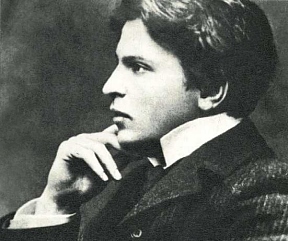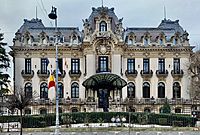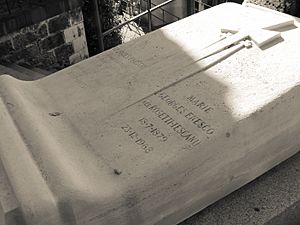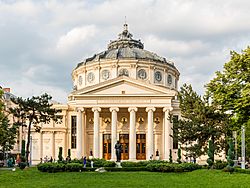George Enescu facts for kids
Quick facts for kids
George Enescu
|
|
|---|---|
 |
|
| Born | 19 August 1881 Liveni-Vârnav, Kingdom of Romania
|
| Died | 4 May 1955 (aged 73) |
| Burial place | Père Lachaise Cemetery, Paris, France |
| Nationality | Romanian |
| Other names | Jurjac, Georges Enesco |
| Citizenship | Romania France |
| Occupation | musician, composer |
|
Notable work
|
Romanian Rhapsodies |
| Spouse(s) | Maria Tescanu Rosetti (m.1939 – 1955) |
| Children | Elena Dinu |
| Parents |
|
George Enescu (born August 19, 1881 – died May 4, 1955) was a famous Romanian musician. He was known in France as Georges Enesco. Enescu was a talented composer, violinist, conductor, and teacher. Many people consider him one of the greatest musicians in Romanian history.
Contents
Biography
George Enescu was born in a small village called Liveni in Romania. This village was later renamed "George Enescu" to honor him. His father was Costache Enescu, and his mother was Maria Enescu. George was their eighth child, but sadly, all his older brothers and sisters had died as babies.
George was a child prodigy, which means he was extremely talented from a very young age. He started trying to compose music when he was just a little boy. Some of his early pieces still exist today. One of his first longer works was called Pămînt românesc ("Romanian Land"). He wrote on it: "opus for piano and violin by George Enescu, Romanian composer, aged five years and a quarter."
When he was seven years old, in 1888, George became the youngest student ever at the Vienna Conservatory. He studied with famous teachers there. He was only the second person allowed to join so young. The rules usually said students had to be at least 14 years old.
In 1891, when George was ten, he played a special concert for Emperor Franz Joseph at the Court of Vienna. One of his teachers, Joseph Hellmesberger Sr., let George stay at his home. There, George met his hero, the famous composer Johannes Brahms.
George finished his studies in Vienna when he was 12. He won a silver medal for his achievements. In his concerts in Vienna, he played music by Brahms, Sarasate, and Mendelssohn.
In 1895, he moved to Paris to continue his music education. He learned violin from Martin Pierre Marsick and composition from Jules Massenet and Gabriel Fauré. He studied at the Conservatoire de Paris until 1899. One of his teachers said he was the only student who truly had new ideas.
When he was 16, in 1898, George showed his first important work in Paris. It was called Poema Română. The Colonne Orchestra, a very famous orchestra, played it.
Musical Style and Influences
Many of Enescu's musical pieces were inspired by traditional Romanian folk music. His most well-known works are the two Romanian Rhapsodies (written in 1901–02). He also composed an opera called Œdipe (finished in 1936).
He wrote five symphonies, which are large musical pieces for an orchestra. He also created many pieces for smaller groups of instruments, known as chamber music. These include sonatas for violin and piano, string quartets, and an octet for strings.
George Enescu was also interested in music from other cultures. The famous Indian musician Ravi Shankar remembered how Enescu practiced with Shankar's brother and his musicians. Enescu also took his young student, Yehudi Menuhin, to see a Gamelan Orchestra from Indonesia.
Career as a Conductor and Teacher
In 1923, George Enescu made his first appearance in America as a conductor. He led the Philadelphia Orchestra in New York City. He visited the United States many times after that. In the 1920s, he also started making recordings as a violinist.
He conducted many American orchestras. In 1936, he was even considered to become the main conductor of the New York Philharmonic. In 1932, he became a member of the Romanian Academy.
In 1935, he conducted the Orchestre Symphonique de Paris. His former student, Yehudi Menuhin, played the violin solo in that concert. Enescu also conducted the New York Philharmonic from 1937 to 1938.
In 1939, he married Maria Tescanu Rosetti. She was also known as Princess Maruca Cantacuzino. She was a close friend of Queen Marie of Romania.
Enescu was also a very respected violin teacher. He taught at the Mannes School of Music starting in 1948. Some of his famous students included Yehudi Menuhin, Christian Ferras, and Ida Haendel. He believed that Bach's Sonatas and Partitas for solo violin were the most challenging pieces for violinists.
He also helped promote music by other Romanian composers. George Enescu passed away on May 4, 1955. He was buried in the Père Lachaise Cemetery in Paris.
Commemorations
Many things have been named or created to remember George Enescu.
- The famous violinist Eugène Ysaÿe dedicated his Violin Sonata No. 3 to Enescu in 1923.
- The Cantacuzino Palace in Bucharest, where Enescu lived, is now the George Enescu Museum. His wife, Maruca, donated the palace to the Romanian state after his death.
- The Symphony Orchestra of Bucharest is named the George Enescu Philharmonic Orchestra.
- A major music festival, the George Enescu Festival, is held in his honor.
- His childhood home in Liveni was opened as a museum in 1958.
- The George Enescu International Airport in Bacău is named after him.
- In 2014, his maternal grandfather's home, where Enescu spent part of his childhood, was saved and turned into a music study center.
- In 2005, George Enescu's picture appeared on the 5 lei Romanian banknote.
Selected works
George Enescu composed many different types of music. Here are some of his most important works:
Operas
- Œdipe, a lyrical tragedy in four acts, Op. 23 (1910–31)
Symphonies
- Symphony No. 1 in E♭ major, Op. 13 (1905)
- Symphony No. 2 in A major, Op. 17 (1912–14)
- Symphony No. 3 in C major, with chorus, Op. 21 (1916–18)
- Symphony No. 4 in E minor (1935; finished by Pascal Bentoiu in 1996)
- Symphony No. 5 in D major, with women's chorus and tenor solo (1941; finished by Pascal Bentoiu in 1995)
Other orchestral works
- Poème roumain, symphonic suite for orchestra, Op. 1 (1897)
- Romanian Rhapsody No. 1 in A major, Op. 11 (1901)
- Romanian Rhapsody No. 2 in D major, Op. 11 (1901)
- Symphonia concertante in B minor, Op. 8 (1901)
- Orchestral Suite No. 1 in C major, Op. 9 (1903)
- Orchestral Suite No. 2 in C major, Op. 20 (1915)
- Orchestral Suite No. 3 in D major Suite Villageoise, Op. 27 (1937–38)
Chamber works
String quartets
- String Quartet No. 1 in E♭ major, Op. 22, No. 1 (1916–20)
- String Quartet No. 2 in G major, Op. 22, No. 2 (1930–32)

Sonatas
- Violin Sonata No. 1 in D major, Op. 2 (1897)
- Violin Sonata No. 2 in F minor, Op. 6 (1899)
- Violin Sonata No. 3 in A minor dans le caractère populaire roumain, Op. 25 (1926)
- Cello Sonata No. 1 in F minor, Op. 26, No. 1 (1898)
- Cello Sonata No. 2 in C major, Op. 26, No. 2 (1935)
Other chamber works
- Octet for Strings in C major, Op. 7 (1900)
- Cantabile et Presto, for flute and piano (1904)
- Decet in D major, for wind instruments, Op. 14 (1906)
- Concertstück, for viola and piano (1906)
- Légende, for trumpet and piano (1906)
- Piano Quartet No. 1 in D major, Op. 16 (1909)
- Impressions d'enfance in D major, for violin and piano, Op. 28 (1940)
- Piano Quintet in A minor, Op. 29 (1940)
- Piano Quartet No. 2 in D minor, Op. 30 (1943–44)
- Chamber Symphony, for 12 instruments, Op. 33 (1954)
Piano music
- Piano Suite No. 1 in G minor, Dans le style ancien Op. 3 (1897)
- Piano Suite No. 2 in D major, Op. 10 (1901/1903)
- Piano Suite No. 3, Pieces impromptues Op. 18 (1913–16)
- Piano Sonata No. 1 in F♯ minor, op 24, No. 1 (1924)
- Piano Sonata No. 3 in D major, op 24, No. 3 (1933–35)
- Piano Arrangement of Romanian Rhapsody No. 1 in A major, Op. 11 (1951)
Songs
- Trois Mélodies, Op. 4 (1898)
- Sept Chansons de Clement Marot, for tenor and piano, Op. 15 (1907–08)
- Trois Mélodies, Op. 19 (1916)
See also
 In Spanish: George Enescu para niños
In Spanish: George Enescu para niños
- Category:Compositions by George Enescu
- George Enescu Philharmonic Orchestra
- George Enescu International Competition
- List of 20th century classical composers





